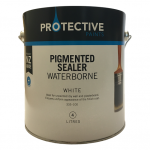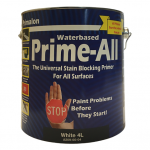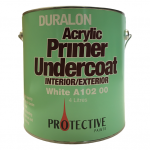Primer, Sealer or Undercoat? What is the Difference?
The paint consumer today is greeted by a confusing array of Primers, Sealers, Undercoats, Primer-Sealers, Primer-Undercoats and even Primer-Sealer-Undercoats.
Why the three terms? What is the difference, if any? What should the consumer or tradesman use?
SEALERS
When applied, sealers are usually, but not always the first coat of paint applied to a substrate, so why not call them Primers, and how do they differ from Primers?
The distinction arises because “sealers” imply the need to ‘seal’, or provide a barrier between a substrate and a finish, in situations where the substrate has an undesirable effect on the finish. For example, ‘Pigmented Sealers’ are alkali resistant turps thinned sealers originally formulated for use on plasterwork and cementitious surfaces to block the alkali in these substrates so that any decorating enamel finish would not be broken down by the lime in the substrate. Sealers can also be applied as a barrier between incompatible finishing coats, particularly when overcoating previous finishes. Hence ‘varnish sealers’ which act as a barrier to bituminous compounds present in
old style oleoresinous varnish stains widely used on timber, particularly timber floors, until the 1950’s.

PRIMERS
As the name implies these are invariably the primary or first coat applied to a substrate. Generally, where a Sealer has been used Primers are not used, so Sealers are in fact Primers with the additional task of sealing in or providing a barrier to something in the substrate. Sealers and Primers can have poor opacity, in some cases only enough colour is present to enable an applicator to ensure an even coat is applied. Depending on the substrate in question the purpose of a Primer is to penetrate and stabilise the substrate and/or to produce a sound surface of uniform porosity so that the undercoat, if any, and topcoats can provide a quality finish with even sheen. A Primer can also act as an adhesion promoter; to ensure good adhesion of the coating system to the substrate, or it can provide corrosion protection or similar additional protection to the substrate by acting as a medium for compounds that protect the substrate.

UNDERCOATS
Where used, the main function of an Undercoat is to obliterate the substrate, ensuring that the overcoating finish produces an even coloured result on the job being painted. Products with combined names fulfil the
demands placed on them to complete each of the above tasks. For example, a
Primer Sealer Undercoat is formulated to provide a barrier for undesirable compounds in the substrate, to protect and even the porosity of the substrate and to obliterate the
substrate so that subsequent finishing coats can provide an opaque finish with even sheen.

Want to know more? Contact us today on 0800 PAINT IT.
